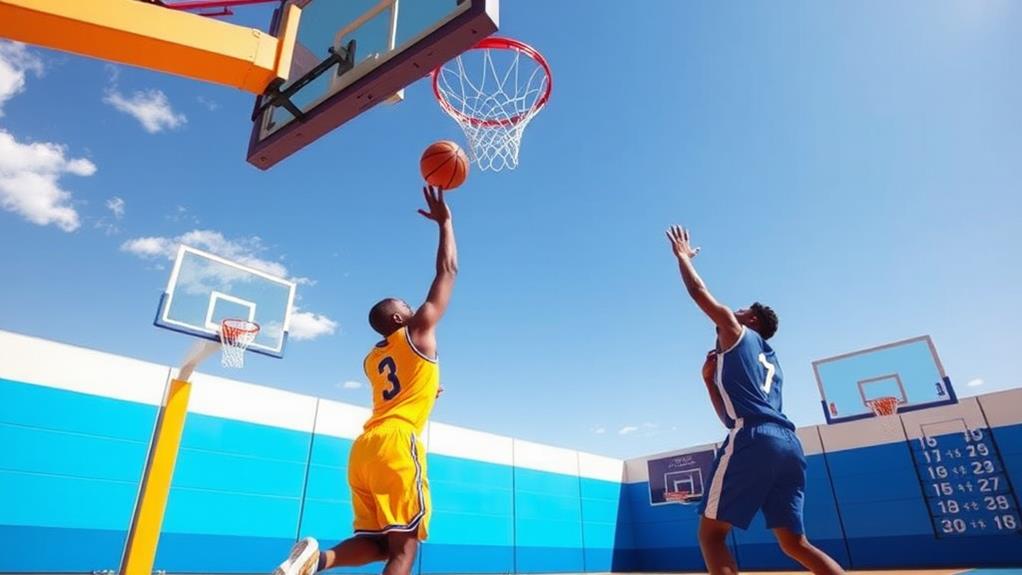
How to Play the Classic 21 Basketball Game
October 7, 2024To play the classic 21 basketball game, gather at least three players and aim to score exactly 21 points. Use standard basketball rules: 2 points for shots inside the arc, 3 points for shots beyond it, and 1 point for free throws. Players take turns shooting, and you should keep track of scores closely. Be mindful not to exceed 21 points, or you'll reset back to a lower score. Use strategic defense and develop your skills to outplay others. For varied experiences, you can also introduce new rules or scoring variations. Keep reading to uncover more tips and strategies!
Overview of the Game
If you're looking for an exciting way to sharpen your basketball skills, "21" is the perfect game for you. This competitive basketball game challenges you to be the first player to score exactly 21 points. Played with three or more players, it allows for individual competition where you can showcase your skills without relying on teammates.
The game's roots in YMCA culture reflect its emphasis on character development and teamwork, making it not just about scoring but also about personal growth and sportsmanship.
The scoring system in "21" follows traditional basketball rules: you score 1 point for free throws, 2 points for shots within the arc, and 3 points for shots beyond the arc. This variety in scoring encourages you to develop a range of shooting skills.
As you play, you'll also enhance your defense and rebounding abilities, all while fostering a competitive spirit.
One of the best features of this basketball game is its flexibility. Players can join or leave the game freely, and the basic rules can be adjusted to add variety and challenge.
Whether you're a beginner or an experienced player, "21" offers a fun way to improve your game while enjoying the thrill of competition. So gather your friends, hit the court, and get ready to play!
Required Equipment
To get started with 21 basketball, all you need is a basketball and access to a hoop, ideally on a full-size court.
Additionally, you might want to take into account the essential equipment such as appropriate footwear to enhance your performance.
You'll want at least three players to kick off the game, but more can make it even more exciting.
Don't worry if you're limited on space; you can easily adapt the game for smaller courts or mini-hoops.
Essential Game Equipment
Playing 21 basketball requires just a few essential pieces of equipment to get started. You'll need a standard basketball and a hoop, which can be found on a full-size court or a smaller setup. The size of the basketball matters, too—men typically use a size 7 (29.5 inches), while women use a size 6 (28.5 inches). For younger players, smaller sizes are available to accommodate their needs.
Understanding the court markings is vital for gameplay. The free-throw line is set at 15 feet from the basket, while the three-point line usually sits at 23.75 feet. This knowledge helps players strategize their shots effectively.
While a full-size basketball court is ideal for a competitive game of 21, you can also play on smaller courts or even with mini-hoops, making it a versatile option for various environments.
The game is designed for at least two players, but having three or more enhances the competition and dynamics of the game. So, gather your basketball, find a hoop, and get ready to enjoy this classic favorite!
Player Count Requirements
A game of 21 basketball is best enjoyed with at least three players, as this number enhances competition and engagement. With two or more people, you create a dynamic atmosphere that makes the game more exciting and competitive. While the classic game can technically be played with just two players, adding more participants greatly improves the overall experience.
The player count requirements allow for a variety of playing styles, as everyone can take on an individual role without specific positions. This setup keeps everyone involved and guarantees the game flows smoothly.
Although a regulation basketball court is preferred for ideal play, 21 can be adapted to smaller courts or even mini-hoops, making it versatile enough for various locations.
Moreover, you can easily accommodate more players if you have a larger group, further enhancing the competitive experience. Whether you're shooting hoops at a local park or in your driveway, having at least three players will elevate your basketball games and keep the energy high.
Player Setup
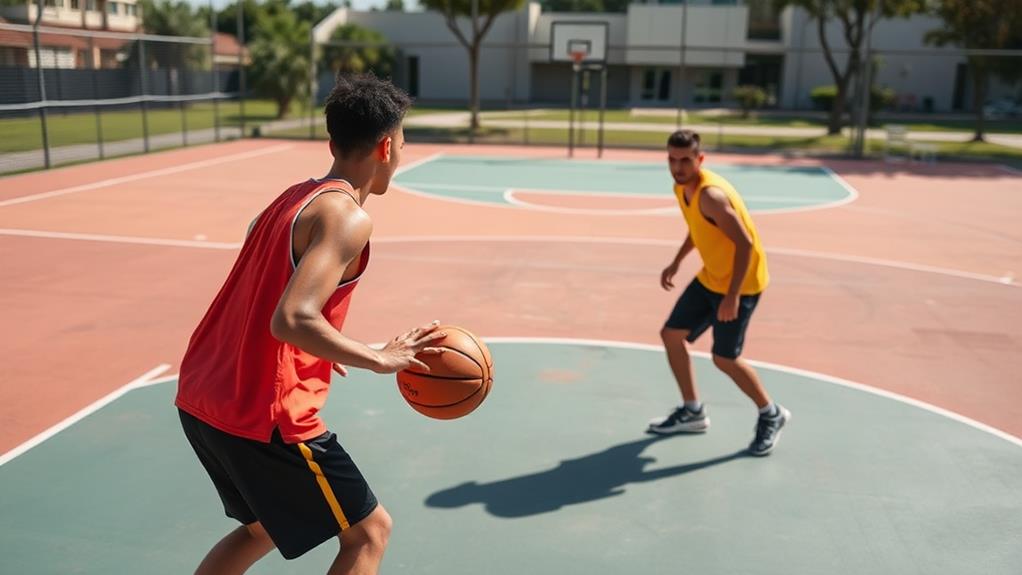
To set up for 21 basketball, you'll need at least two players, since everyone competes individually.
There aren't specific player roles, so everyone gets a chance to showcase their skills.
Make sure you're ready to take turns shooting to determine who starts the game!
Minimum Player Requirement
Starting a game of 21 basketball requires at least two players, but the excitement really ramps up with three or more participants. With the minimum player requirement set at two, you can quickly plunge into the action. Each player acts as their own team, competing individually to be the first to reach 21 points. This individual competition keeps everyone on their toes, as you'll need to outscore your opponents while also playing defense.
One of the great aspects of 21 is its flexibility; as long as there's a basketball hoop, you can play just about anywhere. This versatility allows you to gather friends at parks, driveways, or gymnasiums, making it easy to set up a game.
Plus, players can join or leave freely, accommodating different group sizes and keeping the game dynamic. Even with varying numbers of participants, everyone engages equally in both offensive and defensive actions, ensuring that the experience is fun and competitive for all involved.
Designating Player Roles
Once you've gathered your players, it's time to establish their roles in the game of 21. Start by designating the first shooter; you can do this through fun methods like rock-paper-scissors or shooting to hit the rim. This sets the tone for the game and gets everyone excited to play.
In 21, there aren't specific positions, so each player needs to be adaptable. Every player has the responsibility to score and defend, making it essential to switch roles fluidly as you take turns shooting. This dynamic keeps the game engaging and helps young athletes develop their skills in both offense and defense.
As the game progresses, players will take turns shooting, with the player with possession trying to score points while others defend.
Keep in mind that the house rules can influence how you play, so make sure everyone is on the same page. Remember, players can join or leave the game at any time, allowing for flexible participation. This flexibility adds to the enjoyment and excitement of 21, making it a great way to improve basketball skills while having fun.
Scoring System
In the game of 21 basketball, the scoring system is straightforward yet strategic. You earn 2 points for shots made inside the three-point line and 3 points for shots beyond the arc. After making a successful 2-point shot, you get awarded free throws, each worth 1 point. This means you can quickly rack up points if you play your cards right.
Similar to the rules of soccer, understanding the dynamics of scoring in 21 requires a balance of skill and strategy.
The objective is to be the first player to 21 points. However, you need to be cautious—if you exceed 21, you face penalties, which can reset your score. Keeping track of your score is essential, so announce your points after every successful shot to guarantee everyone's on the same page.
This scoring system encourages you to think strategically. You'll need to weigh the risks of taking high-reward shots while managing your total score to avoid going over 21.
It's a game of skill, where balancing aggression with caution could make all the difference in your quest to win.
Gameplay Mechanics
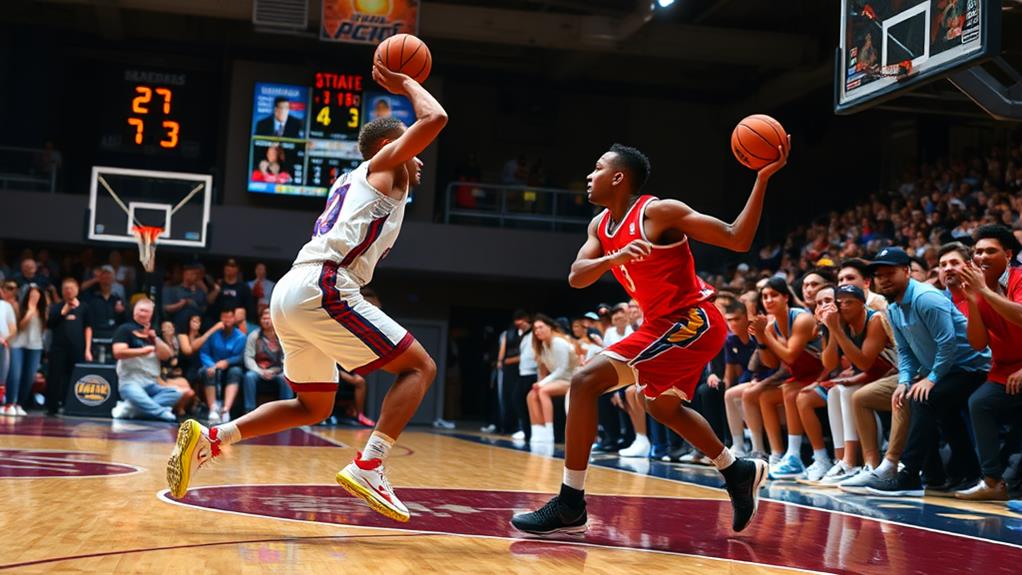
Gameplay mechanics in 21 basketball are designed to keep the action fast-paced and competitive. The offensive player begins at the top of the arc with possession, aiming to score throughout the game while defenders work together to limit their scoring opportunities.
When a player shoots, they can earn 2 points for shots taken inside the three-point line and 3 points for shots beyond the arc. Modern gameplay strategies emphasize the importance of offensive versatility and mismatches, as players aim to create opportunities against defenders.
After a missed shot, players battle for the rebound, and if the offensive player secures it, they get another chance to shoot immediately. Defenders must dribble the ball outside the three-point arc before they can attack the basket after a rebound. This rule adds a strategic layer, forcing defenders to be mindful of their positioning before attempting to guard the offensive player again.
As the game progresses, players need to track their own scores, endeavoring to be the first to reach 21 points and win the game. The mechanics emphasize quick decision-making and agility, keeping everyone on their toes and ensuring a thrilling experience for all involved.
Starting the Game
To kick off the game of 21 basketball, gather at least two players and pick a half-court area with a hoop.
Before starting, it's important to guarantee that all players understand the key regulations of the game to enhance enjoyment and fair play.
Next, decide who gets the first shot through free-throws, three-pointers, or a quick game of rock-paper-scissors.
With the first shooter established, they'll start from the three-point line while others defend against their initial attempt.
Player Setup Process
Starting the game of 21 basketball involves a few simple but vital steps that set the stage for competitive fun. First, gather a minimum of two players, as each will compete individually without teammates.
Designate the free-throw line and the three-point line, which are essential for the game's structure. To determine the first shooter, use a method like rock-paper-scissors or take turns shooting at the hoop rim.
Once the first shooter is decided, they'll start by shooting from the three-point line. The player with the ball attempts to score while other players act as multiple defenders, trying to limit their scoring opportunities.
As the game progresses, opponents can check the player with the ball after each successful shot, adding an exciting challenge.
Remember, players can freely join or leave the game, so don't hesitate to invite others to participate. You can also tweak the rules to make the game more accessible for beginners or to introduce unique challenges that keep everyone engaged.
Enjoy the spirited competition as you aim for that coveted 21 points!
Determining First Possession
Establishing who gets first possession in 21 basketball can set the tone for the game, so it's important to choose a method everyone agrees on. One common approach is to have players shoot a free throw. The player who makes it gains possession of the ball, while if a player misses, the game moves on to the next method.
If you're looking for an alternative method, consider having players take turns attempting 3-pointers. The first player to score earns the initial possession, creating excitement right from the start.
Another quick and fun way to determine first possession is by playing rock-paper-scissors. It's a simple solution that can break any tie or indecision.
In some informal settings, you might opt for a "do-or-die" method, where the first player to hit the rim during a shot gains possession.
No matter which method you choose, establishing a clear starting procedure is essential to guarantee everyone knows how the game begins. This clarity helps maintain the flow and excitement of your 21 basketball game, allowing you to focus on playing hard and having fun!
Initial Shooting Attempt
Once the first possession is determined, it's time to kick off the game. You can start with various methods for the initial shooting attempt. One popular way is to have each player take turns shooting at the hoop rim. The first player who hits the rim gets possession and starts the game.
Alternatively, you might opt for a more challenging approach, where players take 3-point shots. The first player to score from beyond the arc earns the right to begin.
Another common method is to attempt a free throw. If you miss, the player who rebounds the ball automatically gains possession. This adds a bit of pressure, making the initial shot vital.
Once you secure possession, the game officially commences with you taking an offensive shot while the other players try to defend against you.
If you want to keep things light-hearted, a quick game of rock-paper-scissors can also decide who takes the first shot. Whichever method you choose, the initial shooting attempt sets the tone for the game, so make it count!
Fouling Guidelines
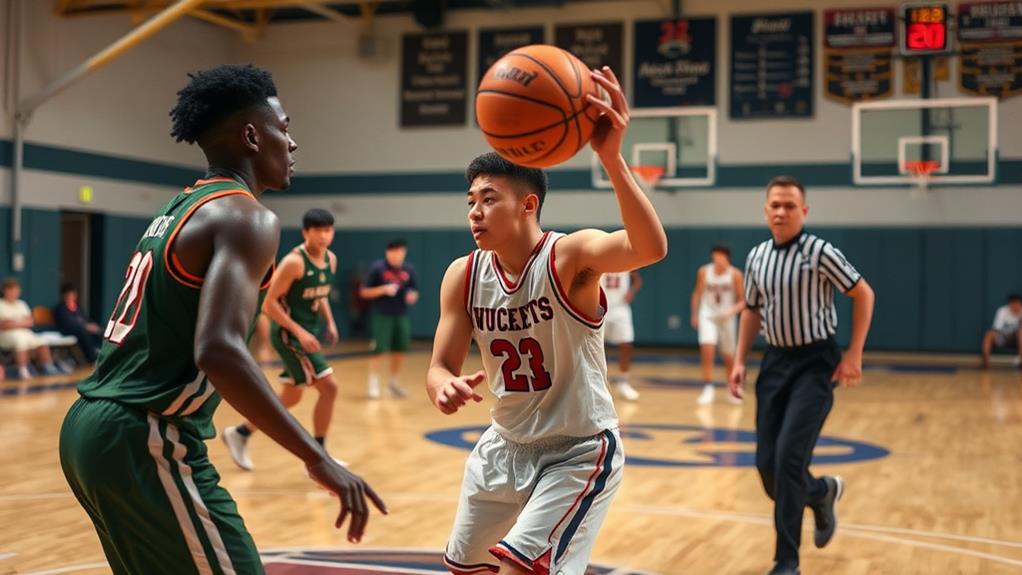
In 21 Basketball, players take on the responsibility of calling their own fouls, which fosters accountability and fair play. Just as in soccer, where yellow cards serve as disciplinary warnings, understanding these distinctions between legal and illegal contact is vital for maintaining the game's flow.
When fouling becomes frequent, it's important to establish clear house rules to guarantee everyone knows what to expect.
Here are some guidelines to follow regarding fouls:
- Calling Your Own Fouls: Always be honest when a foul occurs; players are responsible for their actions on the court.
- Resetting Possession: After a foul is called, the offensive player gets possession at the top of the key, giving them a chance to reset their scoring opportunity.
- Free Throws: If fouls become excessive, consider implementing a rule for free throws, where the fouled player receives one free throw per foul.
- Communicate Clearly: Discuss and agree on what constitutes a foul before starting the game to avoid disputes and maintain sportsmanship.
Defensive Strategies
Maintaining fair play through fouling guidelines sets the stage for effective defensive strategies in 21 Basketball.
To excel in defensive play, you'll want to position yourself strategically outside the paint while teammates focus on blocking shots. This maximizes coverage and reduces your opponents' scoring chances. Implementing principles such as pressure and cover can further enhance your defensive effectiveness.
One key tactic is double-teaming the offensive player. This can disrupt their shooting rhythm and force them into hurried decisions, increasing the likelihood of a missed shot. Additionally, consider switching defenders during gameplay. This keeps matchups fresh and confuses your opponent, making it tougher for them to predict your movements.
Constant communication among players is essential. Guarantee everyone knows each other's positions and can coordinate defensive strategies effectively, especially against a shooter.
Anticipating the offensive player's movements is imperative; position yourself to contest shots, greatly improving your chances of forcing misses.
Game Variations
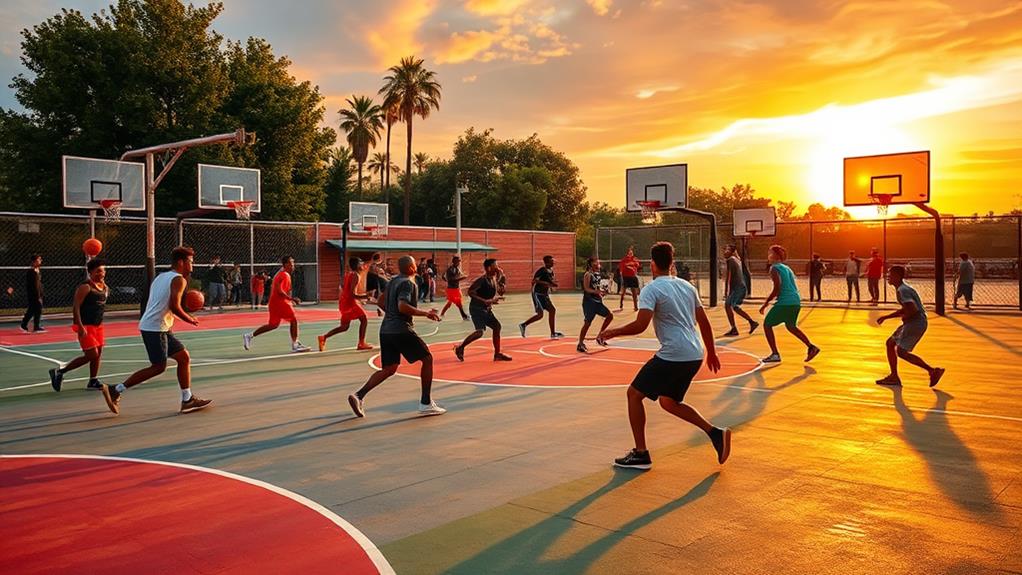
Game variations in 21 Basketball add excitement and challenge to the traditional format, keeping players engaged and competitive.
These modifications can greatly alter gameplay dynamics, so be sure to try them out during your next basketball practice. Incorporating aspects of advancements in game regulations can also enhance the overall experience.
Here are some popular game variations you might consider:
- Point Adjustments: Assign different point values for shots based on distance. For instance, a shot beyond a certain line could be worth four points, while a regular basket is worth two points.
- Fouling-Out Rule: Implement a rule where a player must sit out after committing a set number of fouls. This promotes fair play and helps stop your opponents from excessive contact.
- Rebound Bonus: Allow players to earn extra points for successful rebounds after missed free throws. This encourages aggressive rebounding and adds another tactical layer to the game.
- No Dribble Challenge: Add a rule that prohibits dribbling. Players must pass to move the ball, enhancing teamwork and passing accuracy.
These game variations can greatly enhance your enjoyment and competitiveness, making each session unique!
Tips for Success
To excel in 21 Basketball, honing your shooting accuracy is essential, especially from the three-point line. When you shoot the ball from beyond the arc, each basket is worth three points, allowing you to quickly boost your score. Regular practice will sharpen your aim and increase your confidence.
In addition to shooting, develop your rebounding skills. Securing rebounds means you can take immediate second-chance shots, maintaining possession and increasing your point total. Don't underestimate the power of a solid rebound!
Implement effective defensive strategies, like double-teaming or switching defenders. These tactics can limit your opponents' scoring opportunities and force them into tough shots, giving you a better chance to secure the ball.
Always be aware of your point total. Strategize your shot selection to avoid exceeding 21 points, as this could reset your score and jeopardize your game.
Lastly, call fouls responsibly and maintain sportsmanship. Fostering a fair and enjoyable playing environment enhances the experience for everyone involved.
Conclusion
Now that you know how to play classic 21, grab your sneakers and a ball—it's time to hit the court and channel your inner Michael Jordan! Remember, practice makes perfect, so don't get discouraged if you don't sink every shot right away. Embrace the competition, play fair, and have fun. Whether you're playing with friends or just shooting hoops solo, this game is all about honing your skills and enjoying the thrill of basketball!


